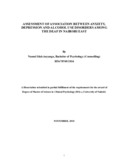Assessment Of Association Between Anxiety, Depression And Alcohol Use Disorders Among The Deaf In Nairobi East
Abstract
Background: Globally, few studies have been done amongst the Deaf, resulting in little empirical data which relates to the prevalence and distribution of psychiatric symptoms and diseases amongst this population. Regionally as well as locally, the same can be inferred as true.
Objective: This study therefore aimed at determining the prevalence of anxiety and depression among the deaf in Nairobi East Dandora. It also looked at assessing the association between anxiety, depression and alcohol use disorders amongst the Deaf in Nairobi East (Dandora, Kayole/Soweto, Mukuru, Kariobangi /Huruma).
Study design: This was a cross sectional descriptive study employing quantitative approach in data collection.
Methodology: A random system search for respondents was done and numbers of respondents were generated. The numbers were extracted from the Deaf Empowerment Kenya register. The respondents upon consent filled in a structured questionnaire consisting of 17 items to check their socio demographic status. Anxiety was measured using the Beck Anxiety Inventory, Depression was measured using the Beck Depression Inventory and Alcohol Use Disorders was measured using the Alcohol Use Disorders Identification Test respectively. A total of 159 respondents took part in the study.
Hypothesis to be tested were:
H1 There is no positive association between anxiety, depression and alcohol use amongst the Deaf.
H0 There is a positive association between anxiety, depression and alcohol use disorders among the Deaf.
xiii
Analysis was done using Statistical Package for Social Sciences (SPSS) version 22 and the results are presented in form of tables, frequency polygons, pie charts as well as bar graphs and narrative. Associations between variables were determined using the Chi square, Correlations was determined using the Cramers Phi Coefficient.
Results: Out of the 159 participants, 59.1% were female and the overall mean age was 32.6 years (± 6.510) years. Most of the participants were single (separated, widowed, and never married) representing over 50% of the total sample population. In connection with education status (44.7%) of the respondents had attained college level of education, while economic status showed (52.2%) were unemployed. A majority (71%) had severe hearing loss. (35.2%) of the respondents had clinical depression, (75.5%) had clinical anxiety and (33.3%) had alcohol use disorder. There was no significant association between depression and alcohol use disorders at a P=0.221. There was also no significant association between anxiety and alcohol use disorders at a P =0.531. However, comorbid depression and anxiety was highly associated with alcohol use disorder at a P = 0.001.
Conclusions: The findings demonstrate that among the deaf in the study site, Nairobi East, a considerable number suffer from anxiety, depression and alcohol use disorder. One of the factors associated with the prevalence was communication barriers leading to feeling of isolation among the deaf persons due to the stigma and inadequate health care geared towards their needs.
Publisher
University of Nairobi
Rights
Attribution-NonCommercial-NoDerivs 3.0 United StatesUsage Rights
http://creativecommons.org/licenses/by-nc-nd/3.0/us/Collections
The following license files are associated with this item:


